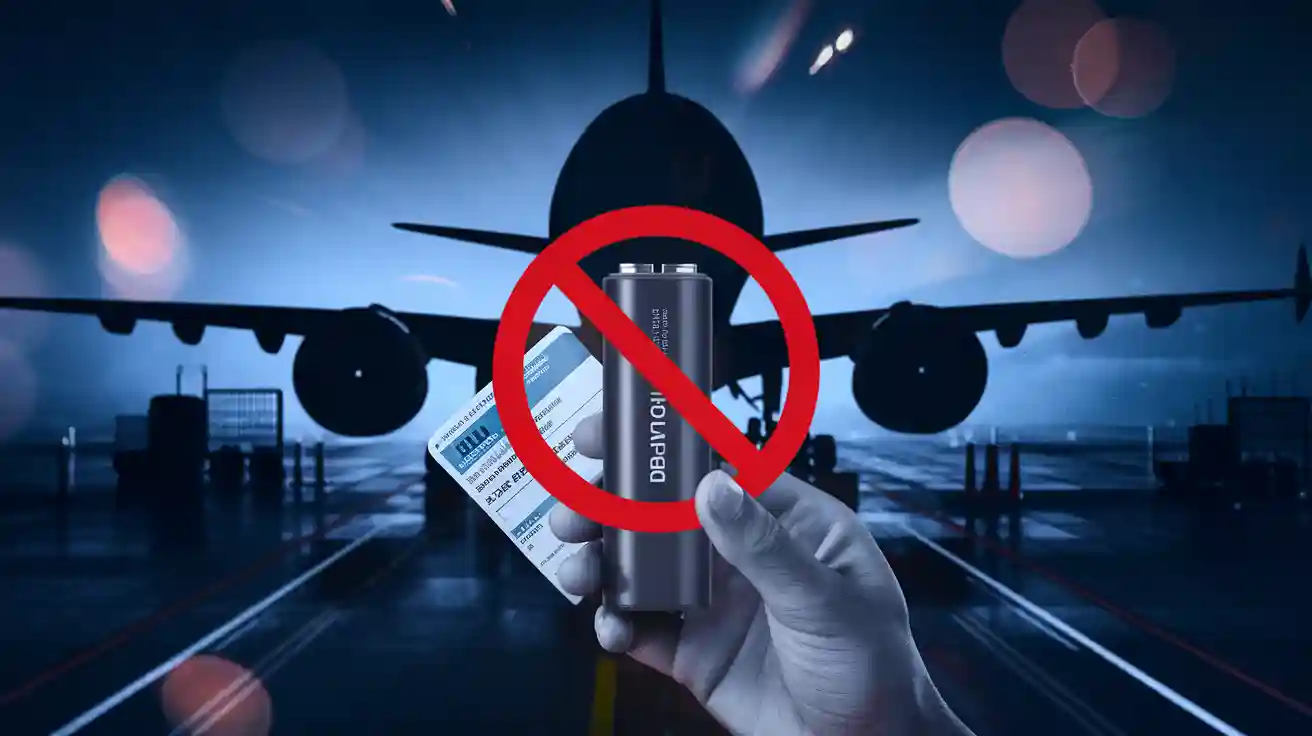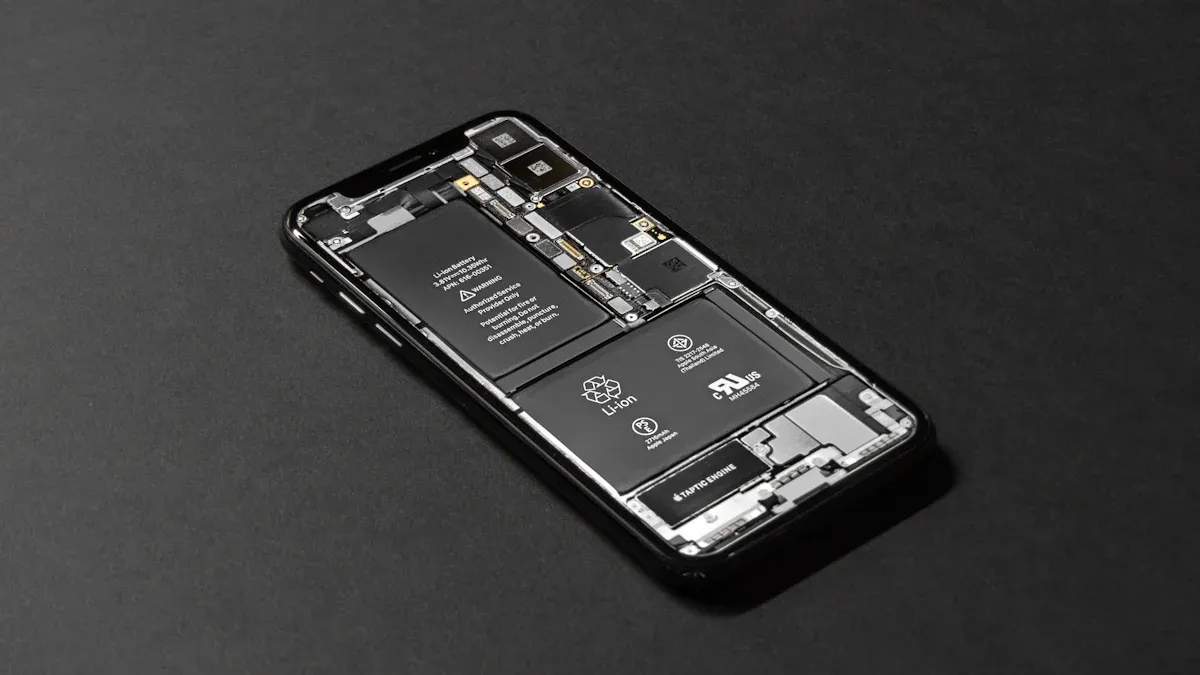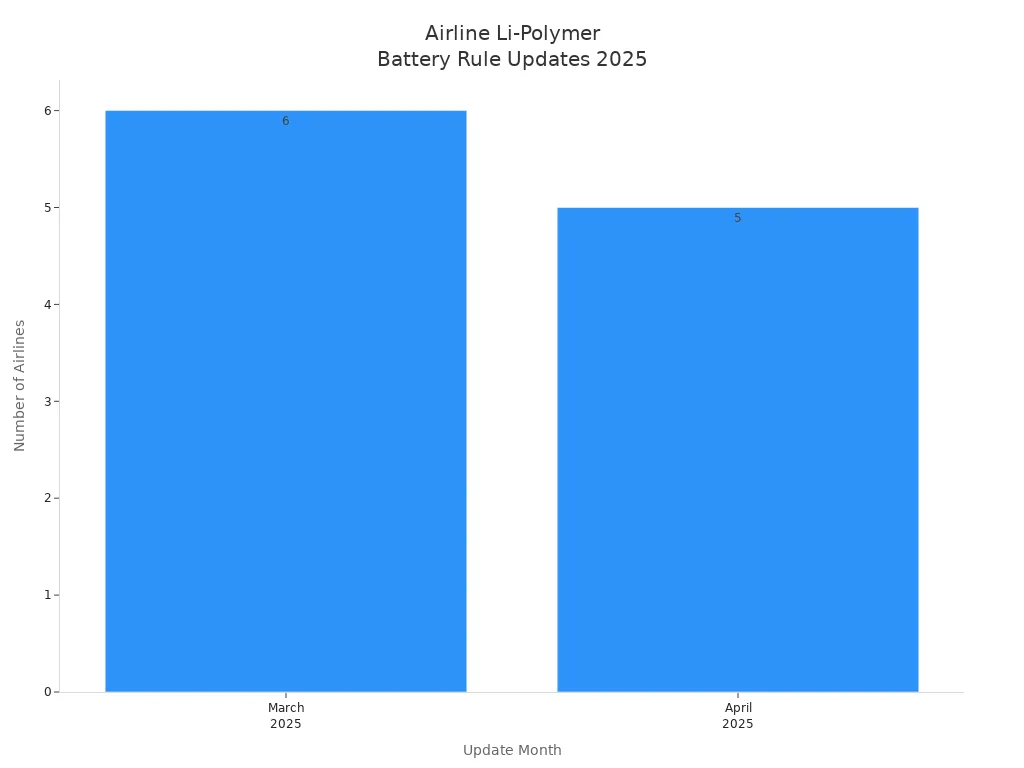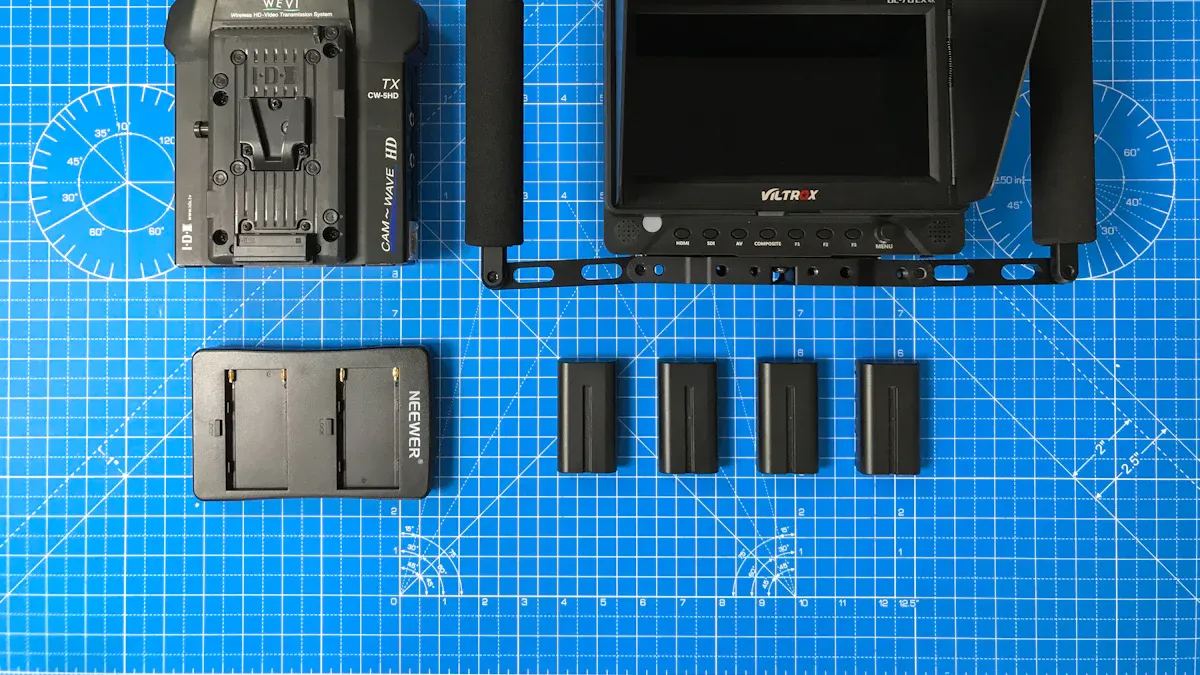
You can bring Li-Polymer batteries on planes, but you must follow strict air travel restrictions. You may pack spare batteries, like a power bank, only in your carry-on luggage. If your battery is under 100 watt-hours, you can bring several in your carry-on. Larger batteries, between 100 and 300 watt-hours, need airline approval and have a two-battery limit. Airlines do not allow Li-Polymer batteries in checked luggage. These regulations help prevent safety issues. With the right steps, traveling with portable batteries and your power bank stays simple.
What Are Li-Polymer Batteries?

Li-Polymer batteries, often called LiPo batteries, are a type of rechargeable battery that you find in many modern devices. These batteries use a gel-like polymer as their electrolyte, which makes them different from traditional lithium-ion batteries. While lithium-ion batteries use a liquid electrolyte inside a hard metal case, Li-Polymer batteries use a flexible aluminum pouch. This design makes Li-Polymer batteries lighter and thinner. You can see them in devices that need to be slim or have unique shapes. The flexible pouch also means you need to handle these batteries with care to avoid damage.
Both Li-Polymer and lithium-ion batteries work using the same basic chemistry. They move lithium ions between the anode and cathode to store and release energy. However, the polymer separator in Li-Polymer batteries can act as a safety feature. It stops the flow of electricity if the battery gets too hot. This helps prevent overheating and makes these batteries safer in some situations. The pouch design also reduces the risk of leaks and helps keep the battery stable.
Общее использование
You use Li-Polymer batteries in many everyday items, especially those you take when you travel. Here are some common devices that rely on these batteries:
- Smartphones and tablets
- Laptops and notebooks
- Cameras and camcorders
- E-readers
- Smartwatches and other wearables
- Electronic games and calculators
Tip: If you travel often, you probably carry several devices powered by Li-Polymer or lithium-ion batteries. These batteries help keep your gadgets light and portable.
Why They Matter for Air Travel
Li-Polymer batteries play a big role in air travel because of their special features. Their высокая плотность энергии lets you store more power in a smaller, lighter package. This is important when you want to keep your luggage light. The flexible shape of these batteries means they fit into slim devices, making your travel gear more compact.
- Li-Polymer batteries can deliver quick bursts of power, which is useful for devices like cameras and drones.
- They have a low self-discharge rate, so your devices stay charged longer, even if you do not use them every day.
- Compared to lithium-ion batteries, Li-Polymer batteries offer more options for shape and size, which helps manufacturers design travel-friendly gadgets.
You need to know about these differences because airlines have special rules for carrying lithium-ion batteries and Li-Polymer batteries. Understanding what makes these batteries unique helps you follow the rules and travel safely.
Air Travel Restrictions for Li-Polymer Batteries
Carry-On Rules
You must follow strict rules when you bring Li-Polymer batteries on a plane. The most important rule is that you can only carry spare batteries and your power bank in your carry-on luggage. Airlines do not allow you to put spare batteries or a power bank in checked luggage. This rule helps keep everyone safe because batteries can catch fire if damaged or short-circuited.
When you pack your carry-on, you should protect each battery. Cover the terminals with tape or keep them in their original packaging. You can also use a fireproof bag for extra safety. If you travel with a power bank, you must keep it in your carry-on and never use or charge it during the flight. Many airlines now require you to store your power bank in a seat pocket or under your seat, not in the overhead bin.
Совет: Always check your airline’s website before you fly. Some airlines have even stricter rules for batteries and power banks.
Checked Luggage Rules
You cannot pack spare Li-Polymer batteries or a power bank in checked luggage. This rule is very clear in both TSA and IATA regulations. If you try to put spare batteries in checked baggage, airport security will remove them. Airlines do allow you to pack devices with batteries installed, like laptops or cameras, in checked luggage. However, you should turn off these devices and pack them carefully.
| Тип батареи | Allowed in Carry-on | Allowed in Checked Luggage |
|---|---|---|
| Spare Li-Polymer Battery | Да | Нет |
| Power Bank | Да | Нет |
| Device with Installed Battery | Да | Yes (must be off) |
Примечание: If you break this rule, you may face penalties or have your batteries taken away.
Capacity and Quantity Limits
Air travel restrictions set clear limits on how many batteries and power banks you can bring and how big they can be. The size of a battery is measured in watt-hours (Wh). You can find this number on the battery label.
- Up to 100 Wh: You can bring several spare batteries or power banks in your carry-on. Most airlines allow up to four, but some have no set limit for personal use.
- 101–160 Wh: You need airline approval to bring these larger batteries. You can only bring up to two in your carry-on.
- Over 160 Wh: You cannot bring these high-capacity batteries on a passenger plane unless they are for special medical devices and you have made arrangements with the airline.
All spare batteries must be protected from short circuits. You should cover the terminals or use a special bag. Here is a quick guide:
| Тип батареи | Max Watt-Hours (Wh) | Quantity Limit | Carry-on | Checked Baggage |
|---|---|---|---|---|
| Standard Li-Polymer Battery | 100 | No airline approval | Да | Yes (if installed) |
| Li-Polymer Battery with Approval | 160 | 2 | Да | Нет |
| Spare Batteries | 100 | Up to 4 (varies) | Да | Нет |
| Power Bank | 100 | Up to 4 (varies) | Да | Нет |
Airlines may have their own quantity limits, so always check before you travel.
Airline Approval Requirements
If you want to bring a battery or power bank that is larger than 100 Wh but not more than 160 Wh, you must get airline approval before your flight. You can only bring up to two of these larger batteries in your carry-on luggage. You must show proof of the battery’s watt-hour rating if it is not marked. The airline may ask you to show the battery at check-in.
- Batteries over 160 Wh are not allowed on passenger flights.
- You must protect all batteries from damage and short circuits.
- If you do not follow these rules, the airline can refuse to let you board with your batteries.
Тревога: Failing to follow airline regulations can lead to fines, confiscation of your batteries, or even legal trouble.
Recent Updates and Stricter Rules
In the past two years, airlines and safety agencies have made air travel restrictions even tighter. This is because of more fires and overheating incidents with power banks and batteries on planes. For example, in January 2025, a fire started on Air Busan Flight 391 because of a power bank in an overhead bin. Many airlines now ban the use and charging of power banks during flights. You must keep your power bank in your seat pocket or under your seat, not in the overhead bin.

Примечание: Always store your power bank where you can see it. Never use or charge it during the flight.
Summary Table: Key Air Travel Restrictions
| Rule Aspect | Подробности |
|---|---|
| Carry-on vs Checked | Spare batteries and power banks only in carry-on luggage; not allowed in checked baggage. |
| Watt-hour Limits | Up to 100 Wh: allowed in carry-on; 101–160 Wh: max 2 with airline approval; over 160 Wh: not allowed. |
| Quantity Limits | Up to 4 spares under 100 Wh (varies by airline); max 2 spares 101–160 Wh with approval. |
| Packing Requirements | Terminals must be covered; use original packaging or fireproof bags. |
| Use During Flight | No use or charging of power banks during flight; keep in seat pocket or under seat. |
| Airline Approval | Needed for batteries 101–160 Wh; not allowed for over 160 Wh. |
You must follow these air travel restrictions to keep your trip safe and avoid problems at the airport. Always check the latest airline regulations before you fly, especially if you carry a power bank or high-capacity batteries.
Why Regulations Exist
Fire and Safety Risks
You might wonder why airlines have strict safety rules for lithium-ion batteries. The main reason is the serious fire risks these batteries pose during air travel. Lithium-ion batteries can overheat and start a battery fire if damaged, overcharged, or exposed to high temperatures. This process, called тепловой удар, happens when the battery’s temperature rises quickly and spreads to nearby cells. Once thermal runaway starts, it becomes very hard to stop.
Here are some of the biggest fire risks with lithium-ion batteries on airplanes:
- Thermal runaway can cause uncontrollable fires that spread fast.
- A battery fire can release smoke, heat, and even explosions.
- Halon fire suppression systems in cargo areas cannot fully put out a lithium-ion battery fire.
- New extinguishing agents like Aqueous Vermiculite Dispersion (AVD) help, but large fires may need to burn out under control.
- Fires from undeclared batteries or bulk shipments are especially dangerous.
Thermal runaway is the main reason lithium-ion batteries are not allowed in checked baggage. Cabin crew can respond quickly to a battery fire in the cabin, but fires in the cargo hold are much harder to control. You should always pack your batteries in your carry-on and follow all safety rules.
Real Incidents
Over the past decade, you have seen a sharp rise in incidents involving lithium-ion batteries on commercial flights. The Federal Aviation Administration (FAA) tracks these events and reports that battery fire, smoke, or extreme heat cases have grown from just 9 in 2014 to over 60 each year by 2022. Most of these incidents happen because of thermal runaway, which can start from overcharging, overheating, or physical damage.
A recent example is the Air Busan flight fire, which started because of a power bank in an overhead bin. This and other events show how quickly a battery fire can threaten everyone on board. Airlines and regulators now pay close attention to lithium-ion batteries and update fire risks guidelines often. You help keep flights safe when you follow the latest rules and pack your batteries the right way.
Packing and Traveling with Portable Batteries

Pre-Flight Checklist
When you prepare for traveling with portable batteries, you need to follow clear guidelines. Use this checklist to stay safe and meet airline rules:
- Place all spare batteries and your power bank in your carry-on bag. Never put them in checked luggage.
- Turn off all devices with batteries. Make sure they are not in sleep or hibernation mode.
- Use strong, rigid packaging for batteries. This protects them from bumps and drops.
- Закройте клеммы аккумулятора изолентой или используйте оригинальную упаковку, чтобы предотвратить короткое замыкание.
- Check your airline’s guidelines for quantity limits and watt-hour ratings.
- If you have smart luggage with a power bank, make sure you can remove the battery.
- Label packages if you travel with extra batteries for work or special equipment.
Tip: Always check the International Air Transport Association (IATA) guidelines before your trip.
Safe Packing Tips
You can reduce risks by following safety measures when packing portable batteries. Always use the original packaging or place each battery in a separate plastic bag. Cover the terminals with non-conductive tape. This prevents short circuits and keeps batteries from touching metal objects. Pack batteries securely in your carry-on so they do not move around. Avoid overpacking your bag to protect devices with built-in batteries.
Keep your power bank and other portable batteries in an easy-to-reach spot. Security officers may ask you to remove them during screening. Never pack loose or unprotected batteries. This can lead to thermal runaway, which is a dangerous fire hazard on planes.
| Packing Tip | Почему это важно |
|---|---|
| Use original packaging or bags | Prevents damage and short circuits |
| Cover terminals with tape | Stops accidental sparks |
| Keep in carry-on only | Cabin crew can respond to emergencies |
| Avoid overpacking | Reduces pressure on batteries |
Handling Damaged or Recalled Batteries
If you find a damaged or recalled battery before your flight, follow these guidelines:
- Do not throw damaged batteries in the trash or regular recycling.
- Place the battery in non-flammable material, like sand or kitty litter, to prevent fires.
- Используйте special packaging designed for damaged batteries if you need to transport them.
- Label the package clearly to show it contains a damaged battery.
- Contact the battery maker or a recycling service for instructions on safe disposal.
- Never bring a damaged battery on a plane. This can cause thermal runaway and endanger everyone on board.
Note: Always follow airline and government guidelines for handling damaged or recalled portable batteries.
Navigating Airline Regulations
Security Screening
When you reach airport security, you need to follow clear steps for your Li-Polymer batteries. TSA officers will check your bags and may ask you to remove batteries or power banks for inspection. You should always carry spare batteries and power banks in your carry-on bag. TSA rules do not allow these items in checked luggage because of fire risks. Devices with installed batteries, like laptops or cameras, can go in checked bags if powered off, but TSA recommends you keep them in your carry-on.
| Тип батареи | Carry-On Bags | Checked Bags |
|---|---|---|
| Spare (uninstalled) lithium batteries | Allowed | Not allowed |
| Installed batteries in devices | Allowed | Allowed (recommended in carry-on) |
You should expect TSA officers to have the final say on what you can bring through the checkpoint. If you follow the rules, you will move through security faster. Always pack your batteries so they are easy to remove if asked.
Совет: Keep your batteries in original packaging or a secure bag, and cover the terminals with tape to prevent short circuits.
Checking Airline-Specific Policies
Every airline can set its own rules for Li-Polymer batteries. Before you book your flight, check the airline’s website for their latest policies. Some airlines may have stricter limits on the number or size of batteries you can bring. You should also visit official resources like the TSA’s Safe Travel with Batteries page for updates.
- Contact your airline directly if you have questions about their rules.
- Review the TSA Blog for safe packing tips.
- If you need more help, reach out to the Hazardous Materials Info-Line or email the airline’s safety team.
You should always verify airline regulations before you travel. Policies can change, so stay informed by checking official websites or subscribing to safety updates. This helps you avoid surprises at the airport and ensures you follow all airline regulations for a safe trip.
You can travel safely with Li-Polymer batteries if you follow airline rules. Always pack loose batteries in your carry-on and protect the terminals. Check your devices for damage before you fly. Keep devices powered off during takeoff and landing. Never charge devices on board. Cabin crew know how to handle emergencies, so notify them if you notice any problems. Careful planning and following these steps help you avoid trouble and enjoy a smooth trip.
- Pack only in carry-on, not checked bags
- Inspect for damage or swelling
- Protect terminals from short circuits
- Follow airline quantity limits
Careful preparation makes traveling with portable batteries easy and safe.
ЧАСТО ЗАДАВАЕМЫЕ ВОПРОСЫ
Can you bring a power bank in checked luggage?
You cannot bring a power bank in checked luggage. You must pack all portable batteries and power banks in your carry-on luggage. This follows airline regulations and helps reduce fire risks during your flight.
What happens if you pack lithium-ion batteries in checked baggage?
If you pack lithium-ion batteries in checked baggage, airport staff may remove them. Regulations do not allow spare batteries in checked luggage because of the risk of thermal runaway and battery fire. Always follow safety rules and pack batteries in your carry-on.
How many portable batteries can you bring on a plane?
Most airlines let you bring up to four spare portable batteries under 100 watt-hours in your carry-on. For high-capacity batteries between 101 and 160 watt-hours, you need airline approval and can only bring two. Always check the latest guidelines before traveling with portable batteries.
Why do airlines have strict rules for batteries?
Strict rules exist because batteries can overheat and cause a battery fire. Thermal runaway can happen quickly. These safety measures protect everyone on board. Following guidelines helps prevent accidents and keeps air travel safe.
Do you need airline approval for all batteries?
You do not need airline approval for batteries under 100 watt-hours. For batteries between 101 and 160 watt-hours, you must get airline approval before your flight. High-capacity batteries over 160 watt-hours are not allowed on passenger flights.

